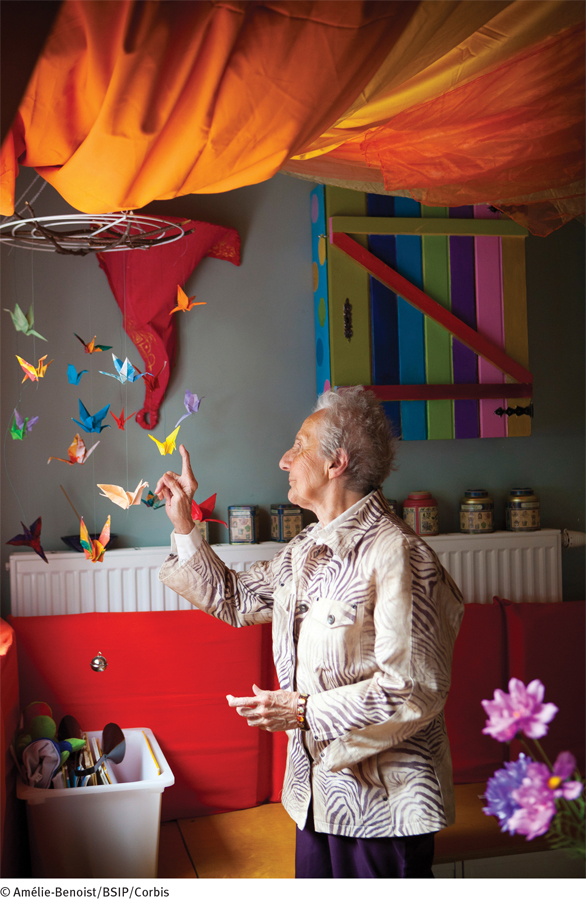18.5 Psychotic Disorders in Later Life

A therapeutic environment Some long-term care facilities have designed their buildings so that the settings address the cognitive and emotional needs of the elderly residents. In this facility, a woman with Alzheimer’s disease is drawn to and touches some of her room’s stimulating objects and is, at the same time, comforted by the room’s soothing colors and decorations.
Elderly people have a higher rate of psychotic symptoms than younger people (Devanand, 2011; Broadway & Mintzer, 2007). Among aged people, these symptoms are usually caused by underlying medical conditions such as neurocognitive disorders, the disorders of cognition that you will read about in the next section. Some elderly people, though, suffer from schizophrenia or delusional disorder.
Actually, schizophrenia is less common in older people than in younger ones. In fact, many people with schizophrenia find that their symptoms lessen in later life (Dickerson et al., 2014; Meeks & Jeste, 2008). Improvement can occur in people who have had schizophrenia for 30 or more years, particularly in such areas as social skills and work capacity, as we are reminded by the remarkable late-life improvement of the Nobel Prize recipient John Nash, the subject of the book and movie A Beautiful Mind.
It is uncommon for new cases of schizophrenia to emerge in late life (Devanand, 2011). Thus some of the elderly people with schizophrenia began receiving anti-psychotic drugs and psychotherapeutic interventions many years earlier in life and are continuing to do so in old age (Cummings & Coffey, 2011). Once again, though, antipsychotic drugs may pose more dangers (cognitive impairment, stroke, seizures) for elderly people than younger people, given the metabolism changes in older people (Dubovsky & Dubovsky, 2011). In contrast, other elderly people with schizophrenia have been untreated for years and continue to be untreated when they are elderly, winding up in nursing homes, in run-down apartments, homeless, or in jail. Among those whose schizophrenia does emerge for the first time during old age, women outnumber men by at least 2 to 1 (Ames et al., 2010).
Another kind of psychotic disorder found among the elderly is delusional disorder, in which people develop beliefs that are false but not bizarre (Cummings & Coffey, 2011; Devanand, 2011). This disorder is rare in most age groups—around 2 of every 1,000 persons—but its prevalence appears to increase in the elderly population (APA, 2013; Chae & Kang, 2006). Older people with a delusional disorder may develop deeply held suspicions of persecution; they believe that other people—often family members, doctors, or friends—are conspiring against, cheating, spying on, or maligning them. They may become irritable, angry, or depressed or pursue legal action because of such ideas. It is not clear why this disorder increases among elderly people, but some clinicians suggest that the rise is related to the deficiencies in hearing, the social isolation, the greater stress, or the heightened poverty that many elderly persons contend with.
